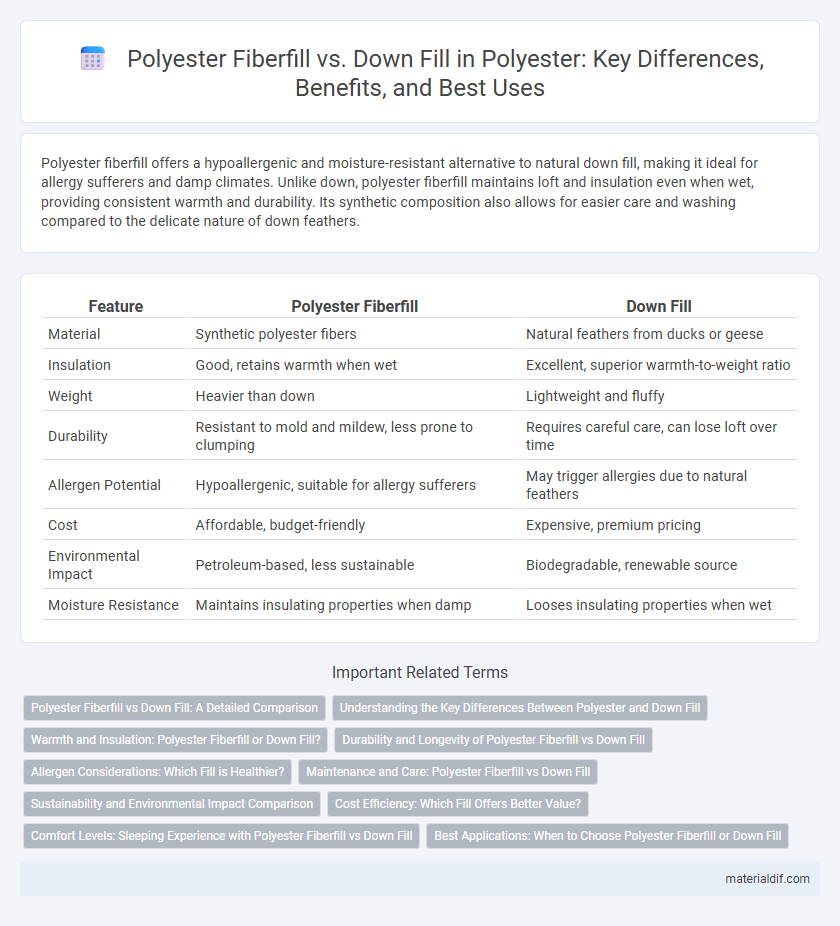Polyester fiberfill offers a hypoallergenic and moisture-resistant alternative to natural down fill, making it ideal for allergy sufferers and damp climates. Unlike down, polyester fiberfill maintains loft and insulation even when wet, providing consistent warmth and durability. Its synthetic composition also allows for easier care and washing compared to the delicate nature of down feathers.
Table of Comparison
| Feature | Polyester Fiberfill | Down Fill |
|---|---|---|
| Material | Synthetic polyester fibers | Natural feathers from ducks or geese |
| Insulation | Good, retains warmth when wet | Excellent, superior warmth-to-weight ratio |
| Weight | Heavier than down | Lightweight and fluffy |
| Durability | Resistant to mold and mildew, less prone to clumping | Requires careful care, can lose loft over time |
| Allergen Potential | Hypoallergenic, suitable for allergy sufferers | May trigger allergies due to natural feathers |
| Cost | Affordable, budget-friendly | Expensive, premium pricing |
| Environmental Impact | Petroleum-based, less sustainable | Biodegradable, renewable source |
| Moisture Resistance | Maintains insulating properties when damp | Looses insulating properties when wet |
Polyester Fiberfill vs Down Fill: A Detailed Comparison
Polyester fiberfill offers superior hypoallergenic properties and resists moisture absorption better than down fill, making it ideal for allergy sufferers and damp environments. Down fill provides exceptional insulation and lightweight warmth due to its natural clusters, but it loses loft when wet and can trigger allergies. Choosing between polyester fiberfill and down fill depends on priorities like allergy concerns, moisture resistance, and desired warmth-to-weight ratio.
Understanding the Key Differences Between Polyester and Down Fill
Polyester fiberfill and down fill differ significantly in insulation properties and maintenance requirements. Polyester fiberfill, a synthetic material made from polyester polymers, offers hypoallergenic traits, easy care, and water resistance, making it ideal for allergy sufferers and wet climates. Down fill, sourced from the undercoating of ducks or geese, provides superior warmth-to-weight ratio and breathability but requires delicate handling and can trigger allergies.
Warmth and Insulation: Polyester Fiberfill or Down Fill?
Polyester fiberfill offers reliable warmth and insulation by trapping air within its synthetic fibers, maintaining performance even when damp. Down fill, derived from the plumage of ducks or geese, provides superior warmth-to-weight ratio and exceptional loft, resulting in better heat retention in cold conditions. While down excels in compressibility and insulation, polyester fiberfill is preferred for its moisture resistance and hypoallergenic properties.
Durability and Longevity of Polyester Fiberfill vs Down Fill
Polyester fiberfill offers superior durability and longer lifespan compared to down fill due to its resistance to moisture, mold, and allergens, which prevents degradation over time. Unlike down, polyester maintains its loft and insulating properties even after repeated washing and exposure to environmental stress. This synthetic fiber's robust structure ensures consistent performance and longevity, making it ideal for products subjected to frequent use and varying conditions.
Allergen Considerations: Which Fill is Healthier?
Polyester fiberfill is hypoallergenic and resistant to common allergens such as dust mites and mold, making it a safer choice for individuals with allergies or asthma compared to down fill. Down fill, sourced from natural bird feathers, often contains allergens that can trigger respiratory reactions in sensitive users. Choosing polyester fiberfill can reduce the risk of allergic responses, providing a healthier sleeping or cushioning environment for allergy sufferers.
Maintenance and Care: Polyester Fiberfill vs Down Fill
Polyester fiberfill is machine washable, retains shape after washing, and resists mold, making it low-maintenance and durable for regular use. Down fill requires delicate care with hand washing or dry cleaning to preserve loft and natural oils, often demanding professional cleaning and longer drying times. Choosing between the two depends on the ease of maintenance needs, with polyester offering practicality and down providing superior insulation at the cost of more complex care.
Sustainability and Environmental Impact Comparison
Polyester fiberfill, derived from petrochemicals, has a larger carbon footprint and contributes to microplastic pollution, whereas down fill, sourced from natural feathers, is biodegradable but may raise animal welfare concerns. Recycled polyester fiberfill reduces environmental impact by repurposing plastic waste, enhancing sustainability compared to virgin polyester. Down's renewable nature and biodegradability offer ecological advantages, but responsible sourcing and certification like Responsible Down Standard (RDS) are critical for minimizing ethical and environmental issues.
Cost Efficiency: Which Fill Offers Better Value?
Polyester fiberfill provides better cost efficiency due to its lower upfront price and durability compared to down fill. While down fill offers superior warmth and lightweight properties, its higher cost and susceptibility to moisture make polyester fiberfill a more practical choice for budget-conscious consumers. The long-lasting resilience of polyester fiberfill also reduces replacement frequency, enhancing overall value.
Comfort Levels: Sleeping Experience with Polyester Fiberfill vs Down Fill
Polyester fiberfill offers consistent loft and hypoallergenic properties, making it suitable for individuals with allergies seeking a uniform sleeping experience. Down fill provides superior insulation and breathability, creating a lighter, more luxurious feel that adapts better to body temperature fluctuations. Choosing between polyester fiberfill and down fill impacts overall comfort by balancing warmth, softness, and allergen sensitivity during sleep.
Best Applications: When to Choose Polyester Fiberfill or Down Fill
Polyester fiberfill is best suited for allergy-sensitive users and outdoor applications requiring moisture resistance and quick drying, such as camping gear and budget-friendly pillows. Down fill offers superior insulation and compressibility, making it ideal for high-performance jackets, luxury bedding, and cold-weather gear where lightweight warmth is essential. Choosing between polyester fiberfill and down fill depends on the need for hypoallergenic properties, durability in wet conditions, and thermal efficiency.
Polyester Fiberfill vs Down Fill Infographic

 materialdif.com
materialdif.com